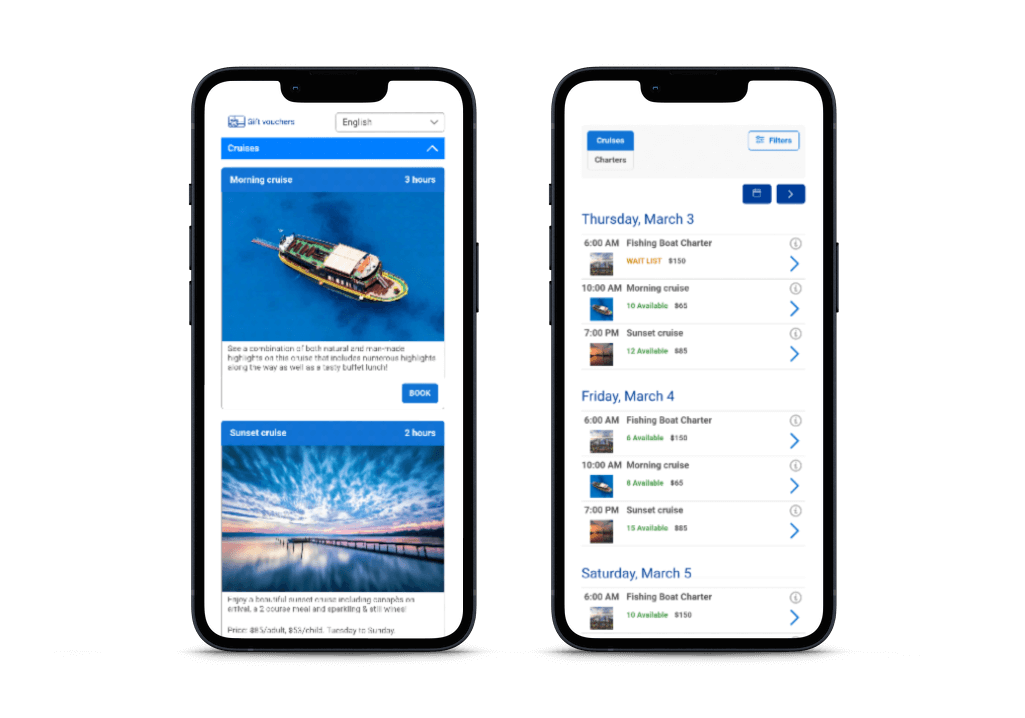
Guide to Writing Boat Charter Business Plan
Thinking of starting a boat charter business? Then you’ve come to the right place.
The private boating industry, including boat charter, has been growing at a steady rate in recent years. The boat charter business is a multi-billion dollar industry, making it a very lucrative business with a lot of growth potential.
However, although it’s definitely a promising business opportunity, it doesn’t mean you’ll automatically achieve success, and one of the most important things you should do is create a comprehensive business plan.
While a business plan is especially important if you’d like to secure funding or investment for your business, a boat charter business plan can also help you in providing a clear roadmap to achieve success.

In this guide, we’ll teach you everything you need to know to about writing an effective business plan for your boat charter business, but you’ll also learn about:
- Choosing the right boat
- How to choose the ideal docking for your boat charter business
- Equipment and supplies you’ll need to start the boat charter business
- Different options you’ll have in starting a boat charter business
- How to promote your boat charter business and attract more clients
Without further ado, let’s start with the basics.
Boat Charter Business Plan: The Concept
A business plan is a document that contains an overview of a business idea—in this case, the boat charter business— and a plan about how this business would be executed and run.

In practice, a boat charter business plan may vary in form and structure depending on various factors; a typical business plan for a boat charter business would follow this basic structure:
- Business Overview
- Company description
- Description of each service and product you’ll provide
- Market research and competitive analysis results
- Funding needs and budget
- Employment plan
- Management structure
- Operational guidelines
The Importance of a Boat Charter Business Plan
A well-written and comprehensive business plan will be beneficial not only for the business owner but also for both internal and external stakeholders of the boat charter business.
Here are a few of those benefits:
1. Securing external funding
One of the key importance of a business plan is to secure external funding for your business (i.e., bank loans, investors, etc.)
For this purpose, the boat charter business plan would play a very important role in proving whether the business is feasible and worth investing in. The business plan can communicate how the boat charter business can effectively generate revenue (and profit), which is essential in convincing banks or investors to fund your business.

A well-written boat charter business plan will also help you showcase to your investors that you—as the business owner/operator—have done your homework and has the ability/experience to run the business.
2. Giving you a roadmap for success
Even if you are not planning to use the business plan for funding purposes, having a clear business plan would give business owners a clear roadmap for success: they can have a bird’s eye view of the business strategy and can stay focused on the steps and tactics that should be taken along the way.

In functioning as a roadmap, the boat charter business plan should:
- Define clear goals and milestones of the boat charter business plan
- Define a timeline of when the milestones should be achieved
- Offer a clear system to measure progress against goals/milestones, enabling business owners and stakeholders to perform risk assessments.
- Provide clear insights into the feasibility of the boat charter business
3. Securing property lease
If you plan to rent a dock or office space for your boat charter business, some landowners may ask to see your business plan to check your business’s feasibility before you can rent their property.
Why? Because your business plan can tell them whether your boat charter company can stay in business for at least three years or more (with 3-5 years being the average length of commercial leases). Most landowners would prefer stability and long-term lease rather than changing tenants every single year.
For this purpose, your business plan can help them in assessing the feasibility of your boat charter business.
4. Convincing partners and vendors
A well-written and comprehensive business plan can help you in convincing prospective business partners or vendors, whether now or in the future.

For example, if you plan to partner with another boat owner in the area or another location to expand your business, the business plan can function as a proposal to secure these future partners.
Boat Charter Business Plan: Section-by-Section Guide
As discussed, a business plan’s structure can vary a lot depending on various factors. However, you can follow the following basic structure when writing a business plan for your boat charter company:
1. Cover Page
Pretty self-explanatory, but don’t underestimate the importance of having a well-designed cover page.
The cover page should be attractive for your readers while fitting your company’s image. Make sure it clearly shows the name of your business, your name (or your CEO’s), and contact information.
2. Executive Summary
Often the most important section of the whole business plan since many readers will only read this opening section of the business plan.
As the name ‘executive summary’ suggests, this section is a summary of all the other sections in the business plan. We’d recommend writing this section last, only after you’ve finished writing all the other sections. This will ensure the executive summary section is complete and well-polished.

Keep the executive summary section brief and short. As a general rule of thumb, the executive summary section shouldn’t exceed 10% of the other section’s total length. Meaning, that if it’s a 20-page business plan, your executive summary should be 1 or 2 pages long.
The executive summary should clearly communicate:
- The company’s mission and vision
- The description of the boat charter industry and the current market environment
- The unique value proposition (UVP) of the boat charter business and the competitive advantages
- Financial potential and anticipation of risk
- Your core management team
- The stage of the business (if you are not starting from scratch)
- The capital that is requested (for external funding purposes)
3. Company Overview
This section should cover a brief but concise description of the boat charter business’s details, including:
- What kind of services you’ll provide, and what products you’ll sell/rent (if any)
- Who is your target clientele
- Why are you starting this business
- What unique value proposition (UVP) will you offer? (What makes you different from other boat charters in the area)
- Your plans for marketing, growth, and monetization

4. Market Research
You can include the following information in this section:
- The demographic data of the business’s primary target market
- The pain points of this target audience and how the boat charter business can be a solution to their problems
- The size of the target market in the area
- Where the target audience spends their time (both in terms of physical locations and online sites/social media platforms they frequent
- Revenue potential
The focus of this section is on communicating who the boat charter business’s target audience is, where to find this audience, and how to win over this target audience. By identifying who the boat charter business’s target clientele is, it’s easier to develop a strategy to attract this target clientele, which will be covered in the next sections.
5. Competitive Analysis
This section will discuss the business’s potential competitors and rivals in the area, as well as their strengths and weaknesses.
Ideally, you should cover an assessment of competitors within a 50-mile range, with an in-depth focus on close competitors within 15 miles. You might want to divide your assessments between direct and indirect competitors.
The focus of this section is to discuss the competitive outlook for the boat charter industry in the area, as well as what distinguishes your business from the competitors.
6. Marketing Plan
This section of the boat charter business plan will cover how you plan to promote your boat charter business and attract target clientele.

This section should cover:
- The products and services you offer
- Pricing strategy for each product or service
- Tactics and strategies for attracting target clientele
- What marketing channels will you leverage to promote your business
- How do you plan to build awareness so your target clientele can recognize your brand
- Elaborating your unique value proposition further, discussing why your target clientele should choose your service over your competitors
7. Services and Products Description
This section should describe the details of all services and products you are going to offer.
If, for example, you are offering multiple boats to rent, then you should describe each of them in this section, as well as the price for each. If you are also providing fishing equipment rental (for fishing boat charter), you should also describe it in this section.
Try to include as much relevant information about the services and products you’re offering in this section.
8. Management Summary
This section will cover the details of your business’s organizational structure and management strategy.
Introduce your team with a brief description of how they are going to deliver the job. List your leaders and their qualifications, and describe their responsibilities in the boat charter business.

The main focus of this section, especially if you are going to present this business plan to outside investors, is to prove your team’s ability, knowledge, skills, and experience to work together when running and growing the boat charter business.
Many investors will put much focus on studying this section, so make sure to curate this carefully.
9. Operational Plan
Elaborate on how you plan to run your boat charter business, including the detailed logistics of the business.
Consider including the following information:
- The exact address of your location (or locations)
- Your business’s opening hours
- What kinds of staff will the business need, and how many
- How will you plan to scale/expand the business over time
10. Financial Plan
This section should cover the current and future projections of the boat charter business’s financial performance and should focus on these key components:
- Capital requirements: how much money are you going to raise (i.e., how much do you need from investors), and how this money will be spent? You may also detail the startup cost and operational expenses of the business.
- Financial assumptions: assumptions regarding business growth should always be backed by experts’ opinions and/or evidence.
- Income statement: forecasting the business’s performance for the next three to five years. You may also include balance sheets in this section.
- Cash flow statement: should focus on proving whether the boat charter business is successful in turning profits into cash.
Boat Charter Business Plan: Actionable Tips and Best Practices
Different Types of Boat Charter Business
A boat charter business can be presented in several different models with different offers. However, all boat charter businesses should offer at least one of these three offerings:
- The boat itself: different sizes and types of boats may dictate the rental price.
- Destination/location: for example, if you are the only boat charter business in a famous tourist location, then it’s a major competitive advantage. You may also offer guided tours and boat rentals to famous destinations.
- Personnel: staff/employees/experts that can deliver value to your clientele, like an expert tour guide, an expert fisherman giving a guided fishing tour, a famous celebrity chef onboard, and so on.

With that being said, in general, there are two basic variations of the boat charter business:
- You are just renting your boat, and the client is the one responsible for provisioning and navigating the boat (i.e., they’ll drive the boat by themselves.)
- You offer a professional captain and/or guide to navigate the boat, and you may also offer customized provisioning and itinerary. Often called a boat tour business model.
Assess the geographical location you plan to operate In, the competitors in your area, and especially your target clientele’s preferences when choosing the right type/business model you are going to offer.
The better your business caters to your target clientele’s needs and becomes a solution for their problems, the more likely you’ll achieve success.
Boat Charter Business: Licensing and Certification Requirements
Don’t underestimate the importance of meeting the legal requirements in your area regarding permits and license requirements. Failure to do so might result in a hefty penalty and legal repercussions, which can significantly hurt your boat charter business.

Most states in the US would mandate at least a boat safety course before you can rent your boat to others, with few exceptions. Check out with local authorities about which courses you are legally required to take, just to be sure.
Merchant Mariner Credential (MMC)
If you are looking to make money on a boat or yacht on US soil—including renting your boat in a boat charter business—you are legally required to get a Merchant Mariner Credential or MMC.
The MMC is issued by the US Coast Guard, so you can check the USCG website for MMC here, or contact any school licensed by the USGC to get more information regarding getting an MMC.
You may be required to get different types of MMCs depending on:
- The size of the boat, according to the tonnage determined by the USCG
- The number of passengers you’ll take on the boat. If you only take no more than six passengers at a time, you don’t need to get a Master’s license, but you can operate your business with just an OUPV (Operator of Uninspected passenger Vessel,) which is more affordable and easier to obtain.
- USCG offers Inland, Great Lakes, and Near Coastal MMC licenses based on where your boat is going to operate.
Other legal requirements to consider:
- If you plan to run a fishing boat charter service, you may be required to obtain a fishing guide license. This is especially true if you are planning to offer fishing tours. This requirement may vary between states, so check with your local authority.
- You may need to obtain licenses and permits required by federal regulations, including Doing Business As (DBA) license and health permits and licenses from the Occupational Safety and Health Administration (OSHA)

You may also be required to obtain other industry-specific licenses and permits (city, local county, or state-level), depending on your location. You can check with this SBA’s (Small Business Administration’s) guide for your state’s specific requirements.
Choosing the Ideal Location for Your Boat Charter Business
When it comes to location, there are two different aspects you should consider for a boat charter business: office location and dock location.
Office location
You can technically start the boat charter business from your home or your garage to lower your startup costs.

However, having a proper office space may be a better long-term choice, especially when you need to integrate more employees into your team. If your budget allows, having the office space closer to where you dock your boat or boats is typically better.
Dock location
As a general rule of thumb, you’d want to rent (or purchase) a docking space that is located in an area frequented by your target clientele. Typically in most docking locations, you can either purchase or rent a “slip” (the right to dock your boat), which will vary in cost.

Here are some considerations:
- Public docks are typically cheaper, but you’ll need to carefully evaluate security factors since they tend to be less secure.
- Private marinas, on the other hand, are typically more expensive but also more secure than public docks.
- Joining a yacht club (if you rent a yacht or yachts) is the most secure option, and you may also get additional services and features. However, obviously, they can be very expensive.
- The ideal docking location would also depend on the types of boat charter or tour services you’d provide. For example, if you plan to provide tours, then you’d want to choose a dock located on or near the popular tourist destinations in your area.
Tools like DockSearch.com can help you easily find ideal docking locations for your boat or boats, so use them to your advantage.
Establish a Strong Online Presence
Having a strong online and social media presence is crucial in this digital age.
If your target clientele can’t find your boat charter business when they conduct a Google search or browse social networks, your business simply doesn’t exist for them, and obviously, you won’t get any business in such cases.
To ensure success, you’d want to establish a strong presence in at least four areas;
1. Professional and well-designed website
In the past, building a professional-looking and functional website could be very expensive, and you may be required to hire a fully-fledged digital agency just to have a website running.

Nowadays, however, that’s no longer the case, and building a website is now much cheaper and easier, thanks to platforms like Wix or WordPress, among others.
In short, there’s simply no excuse not to have a well-designed website that:
- Is mobile-friendly or mobile-responsive
- Loads fast (less than three seconds in a standard connectivity
- Contain complete information about the services and products you offer
- Rich with valuable, relevant, and attractive content to attract your target market
- Has a reliable 24/7 online booking functionality
2. 24/7 online booking
In this post-pandemic world, people simply expect the convenience of online 24/7 tour booking, including when they’d like to rent their boat.
Consider investing in a reliable online booking system or software to ensure it’s as easy as possible for your clients to book your boat tours.

3. Social media presence
Create and optimize profiles on relevant social networks. Instagram is an obvious choice nowadays due to its popularity, but you may also want to consider other networks like Facebook, Twitter, YouTube, and even less obvious ones like LinkedIn.

4. Google Maps
People will use keywords like “boat charter near me” or “boat charter in (your city name.”) when they’d like to charter a boat from someone.
If your business doesn’t appear when your target clientele searches for such keywords, you are simply missing out.
The goal is to rank as high as possible on Google Maps, and you can do so by following these steps:
- Claiming and verifying Google Maps/Google Business listing
- Optimizing your Google Business Listing, focus on providing accurate and complete information for your clientele.
- Building local citations by listing your boat charter business on relevant online directories
- Getting more reviews from existing clients, especially on Google Maps but also on relevant review sites/platforms

By doing these four steps consistently, you’ll see your boat charter business listing slowly but surely climbs the Google Maps ranking.
Wrapping Up
Having a well-written and comprehensive business plan can have so many different benefits for the boat charter business, especially in how it provides a clear roadmap to success.
Above, we have discussed the step-by-step guide to writing a boat charter business plan, and we’ve also shared actionable tips and strategies to help you make the most of your business plan.
By following the tips we’ve shared above, you can start planning, setting up, and running your own charter boat and tour business in no time.

